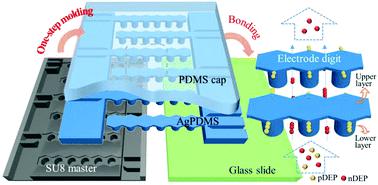Our official English website, www.x-mol.net, welcomes your feedback! (Note: you will need to create a separate account there.)
A one-step molded microfluidic chip featuring a two-layer silver-PDMS microelectrode for dielectrophoretic cell separation.
Analyst ( IF 4.2 ) Pub Date : 2020-06-23 , DOI: 10.1039/d0an01085e Zhongle Zhang 1 , Yuan Luo , Xiaofeng Nie , Duli Yu , Xiaoxing Xing
Analyst ( IF 4.2 ) Pub Date : 2020-06-23 , DOI: 10.1039/d0an01085e Zhongle Zhang 1 , Yuan Luo , Xiaofeng Nie , Duli Yu , Xiaoxing Xing
Affiliation

|
Dielectrophoresis (DEP) is a powerful technique for label-free cell separation in microfluidics. Easily-fabricated DEP separators with low cost and short turnaround time are in extremely high demand in practical applications, especially clinical usage where disposable devices are needed. DEP separators exploiting microelectrodes made of conducting polydimethylsiloxane (PDMS) composites enable the construction of advantageous 3D volumetric electrodes with a simple soft-lithography process. Yet, existing devices incorporating microelectrodes in conducting PDMS generally have their fluidic sidewalls constructed using a different material, and consequently require extra lithography of a sacrificial layer on the semi-finished master for molding the electrode and fluidic sidewalls in separate steps. Here we demonstrate a novel microfluidic DEP separator with a 3D electrode and fluidic structure entirely integrated within silver-PDMS composites. We develop a further simplified one-step molding process with lower cost using a readily-available and reusable SU8 master, eliminating the need for the additional lithography step in existing techniques. The uniquely designed two-layer electrode exhibits a spatially non-uniform electric field that enables cell migration in the vertical direction. The electrode upper layer then offers a harbor-like region for the trapping of the target cells that have drifted upwards, which shelters them from being dragged away by the main flow streams in the lower layer, and thus allows higher operation flow rate. We also optimize the upper layer thickness as a critical dimension for protecting the trapped cells from high drag and show easy widening of our device by elongation of the digits. We demonstrate that the elongated digits involving more parallel flow paths maintain a high capture efficiency of 95.4% for live cells with 85.6% purity in the separation of live/dead HeLa cells. We also investigate the device feasibility in a viability assay for cells post anti-cancer drug treatment.
中文翻译:

一步成型的微流控芯片,具有两层银-PDMS微电极,用于介电泳细胞分离。
介电电泳(DEP)是一种用于微流控中无标记细胞分离的强大技术。在实际应用中,特别是在需要一次性装置的临床应用中,对低成本,周转时间短的易于制造的DEP分离器有很高的要求。利用由导电聚二甲基硅氧烷(PDMS)复合材料制成的微电极的DEP隔离器可通过简单的软光刻工艺构造出有利的3D体积电极。然而,在导电PDMS中结合有微电极的现有装置通常具有使用不同材料构造的流体侧壁,因此需要在半成品母板上进行牺牲层的额外光刻,以在单独的步骤中模制电极和流体侧壁。在这里,我们展示了一种新型的微流体DEP分离器,该分离器具有3D电极和完全集成在Silver-PDMS复合材料中的流体结构。我们使用易于获得和可重复使用的SU8母版,以更低的成本开发了进一步简化的一步成型工艺,从而消除了现有技术中额外的光刻步骤。独特设计的两层电极展现出空间上不均匀的电场,该电场使得细胞可以在垂直方向上迁移。然后,电极上层提供了一个港湾状区域,用于捕获向上漂移的目标细胞,从而避免了它们被下层中的主流拖走,从而允许更高的工作流速。我们还优化了上层厚度,将其作为保护被困细胞免受高阻力的关键尺度,并通过手指的延长显示出我们的设备易于拓宽。我们证明,涉及更多平行流动路径的细长手指在活/死HeLa细胞分离中,对活细胞具有95.4%的高捕获效率,纯度为85.6%。我们还研究了抗癌药物治疗后细胞活力测定中的设备可行性。
更新日期:2020-08-10
中文翻译:

一步成型的微流控芯片,具有两层银-PDMS微电极,用于介电泳细胞分离。
介电电泳(DEP)是一种用于微流控中无标记细胞分离的强大技术。在实际应用中,特别是在需要一次性装置的临床应用中,对低成本,周转时间短的易于制造的DEP分离器有很高的要求。利用由导电聚二甲基硅氧烷(PDMS)复合材料制成的微电极的DEP隔离器可通过简单的软光刻工艺构造出有利的3D体积电极。然而,在导电PDMS中结合有微电极的现有装置通常具有使用不同材料构造的流体侧壁,因此需要在半成品母板上进行牺牲层的额外光刻,以在单独的步骤中模制电极和流体侧壁。在这里,我们展示了一种新型的微流体DEP分离器,该分离器具有3D电极和完全集成在Silver-PDMS复合材料中的流体结构。我们使用易于获得和可重复使用的SU8母版,以更低的成本开发了进一步简化的一步成型工艺,从而消除了现有技术中额外的光刻步骤。独特设计的两层电极展现出空间上不均匀的电场,该电场使得细胞可以在垂直方向上迁移。然后,电极上层提供了一个港湾状区域,用于捕获向上漂移的目标细胞,从而避免了它们被下层中的主流拖走,从而允许更高的工作流速。我们还优化了上层厚度,将其作为保护被困细胞免受高阻力的关键尺度,并通过手指的延长显示出我们的设备易于拓宽。我们证明,涉及更多平行流动路径的细长手指在活/死HeLa细胞分离中,对活细胞具有95.4%的高捕获效率,纯度为85.6%。我们还研究了抗癌药物治疗后细胞活力测定中的设备可行性。



























 京公网安备 11010802027423号
京公网安备 11010802027423号